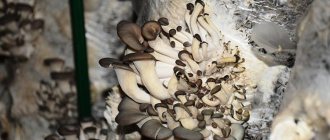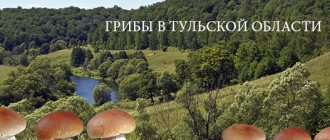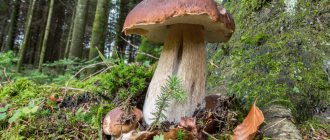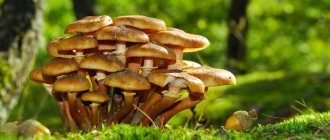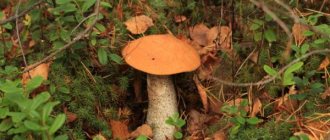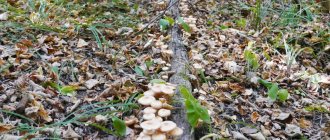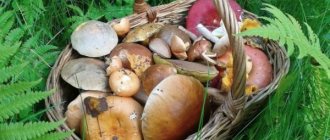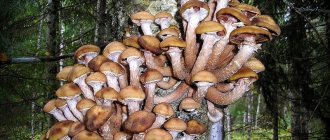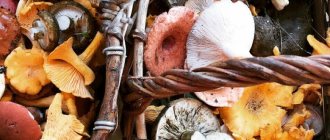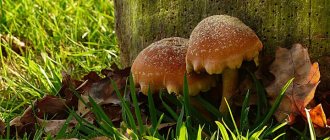Where can you find mushrooms
Professional mushroom pickers shared the list:
- The village of Malaya Malyshevka. Mushrooms in Samara, or rather the region, can be found here. Approaching this village, you need to turn near the sign that leads to Spiridonovsky Forest. As experienced mushroom pickers say, you can find a large number of oyster mushrooms and morels here. To get to the forest without a car, you need to take a bus in the Samara-Bogatoye direction, which will stop at the village of Malaya Malyshevka along the way.
- Village Shiryaevo. Outside the village, a huge variety of mushrooms grow. Here you can collect boletus, oyster mushrooms, and honey mushrooms.
- Mushrooms in the Samara region also grow in the Sergievsky district. On the road from Sukhodol in the direction of Kinel-Cherkassy there are large and beautiful birch plantations. People will be able to find here a variety of butter mushrooms, milk mushrooms, and honey mushrooms.
- Borsky district. The best mushrooms in the Samara region grow in the village of Borskoye. About 100 meters from it there is an excellent pine forest. Mushroom pickers say that here you can find boletus, russula, and porcini mushrooms.
- Bogatovsky district. You need to get to the Borsky district, where on the border with Bogatovsky you can see a large forest that will delight you with an abundance of honey mushrooms and boletus. If you take a good look and walk along it, you will definitely come across clearings with oyster mushrooms and porcini mushrooms.
- Shigonsky district. Not far from the famous sanatorium “Volzhsky Utes” there is a forest where honey mushrooms, butter mushrooms and even everyone’s favorite champignons are found. But people who prefer to drive a car will have to walk to the forest and leave the car a hundred meters from the sanatorium.
- There are mushroom places in the Samara region, which are located directly in the city of Samara. Behind the village of Mekhzavod there is a small forest where mushroom pickers always collect honey mushrooms and porcini mushrooms.
- Village Managerial. There is a birch grove of amazing beauty, and on its outskirts there are clearings with well-known honey mushrooms. In the middle of the grove you can enjoy an abundance of boletus and russula.
- The village of Kurumoch. It is located towards the Coastal region. You can come from the forest with honey mushrooms, butter mushrooms, oyster mushrooms, and milk mushrooms.
- Mushroom places in the Samara region are located in the forests that grow near the village of Novosemeikino. Oyster mushrooms, boletus and honey mushrooms always grow here in abundance.
Rare varieties
The entire central zone of Russia is dotted with almost the same species of mushrooms, but in the Samara region there are also rare representatives of this kingdom.
Truffle
The most expensive type of mushroom is the truffle. It grows underground and is considered a delicacy. The cost for 1 g of truffles in a dish can range from 400 to 1000 rubles. Mushroom pickers will only be able to find it with the help of specially trained dogs or pigs. There are black, winter and Italian truffles.
Truffles are eaten fresh
Growing is also possible in artificial conditions, but this is a very costly and risky business, because the mushrooms may simply not grow.
One of the types of truffles found in the region is the black Russian truffle (Tuber aestivum), or summer truffle. The average weight of its fruiting body is about 400 g with a diameter of up to 10 cm. The pulp of this species is characterized by the following qualities:
- taste: sweetish, nutty with an original taste of algae;
- Color: usually whitish in young specimens, yellow or gray-brown in mature specimens. The pulp contains a large number of whitish veins, which form a characteristic marble pattern;
- density: in young people it is very dense, in older ones it is soft and loose.
This is the only representative of the Tuber genus on the territory of the Russian Federation.
The fungus is a mycorrhiza-former and forms fungal roots with various representatives of tree species:
- very often with oak, beech, hornbeam, and other broad-leaved species;
- less often with birch trees;
- very rarely with pine trees.
The fruiting body develops shallowly in the soil - up to 15 cm, the maximum, but very rare development depth is 30 cm.
It grows in groups - nests in which up to 7 fruiting bodies develop. You can go out in search of black Russian truffles in mid-June and until October.
Truffles have a very short shelf life; they are eaten only fresh.
The mushrooms themselves are round, fleshy, and have a cartilaginous consistency. When cut, the pulp forms a marble pattern of black and light veins. They are no bigger in size than potatoes.
Real morel
This type of mushroom is considered elite. There is a variety with a similar name - stitch, but other than that they have nothing in common. The stitch is poisonous and has a curved cap.
True morels begin to grow in April. It can be seen next to aspen, alder or poplar. The size of the mushroom is up to 15 cm, the cap is ovoid, gray-brown, with uneven edges that develop into a stalk. This mushroom is not like other species. The leg is white, widened downwards. The pulp is waxy, with a pleasant aroma and taste.
Unlike strings, which contain toxins, morels are not poisonous.
Hedgehog
The mushroom looks like a chanterelle. The surface of the cap is smooth or with pimples. On the reverse side there are “thorns”. The following types of blackberries are found in the region: combed, variegated, coral-shaped, notched, yellow. Can be collected from July to November.
The most common is the notched hedgehog, which is extremely similar to real chanterelles. However there are differences:
- cap: irregularly shaped, tuberculate;
- hymenophore: needle-shaped, represented by peculiar cream or light yellow spines descending onto the stalk;
- pulp: dense and at the same time brittle, yellowish, when scrapped it changes color to brownish-yellow. In older specimens it is hard and bitter. That is why only young mushrooms are suitable for consumption.
The species of blackberry (hericium) coral-shaped is included in the Red Book of the Samara Region.
When is the best time to pick mushrooms?
Experienced mushroom pickers say that it is best to listen to the opinions of people who regularly travel to the forest. It is known that each individual species grows in a certain period, so it would be useful to read specialized literature to understand how and when mushrooms grow in the Samara region. After reading, an excellent option is to compile a table where the approximate collection dates will be clearly outlined.
In order to find the places where mushrooms grow in Samara, experts advise getting up early in the morning and going to the nearest forest. Morning picking is necessary so that the sun does not heat the mushrooms and they do not spoil. In some cases, they can even become dangerous to human health. Experienced mushroom pickers advise not to follow already trodden tracks, paths and clearings. But if you arrive in the forest before everyone else, you can be the first to harvest from the young shoots.
Picking mushrooms is an activity for patient people, this also needs to be remembered.
What is the best time to pick mushrooms?
If you have the opportunity and desire to visit mushroom places in the Samara region, then you need to take care of the container in which they will be collected. It is best to take wicker baskets or wooden boxes with you, which will perfectly preserve the harvest during transportation. It is permissible to place no more than 2.5 kilograms of mushrooms in one basket, otherwise they may release juice due to severe pressure. But it is worth noting that saffron milk caps and milk mushrooms are perfectly transported in any containers, since they are drier.
Some people do not adhere to these rules and use plastic buckets. In order for the mushrooms to successfully travel the long way to the house, people drill small holes in them on the walls for ventilation. But under no circumstances should you collect mushrooms in plastic bags, because the harvest in them will quickly crumble and dry out.
Advice from experienced mushroom pickers
In the vicinity of Samara and throughout the region, you can count about 200 species of mushrooms. Most of them are classified as conditionally edible and edible; there are also inedible and poisonous ones. Before you go on your first trip to pick mushrooms, you should study the descriptions of the most common species and where they grow. The best time for quiet hunting is early morning, when the legs and caps are the strongest and most elastic. At this time, the mushrooms are suitable for transportation and do not wrinkle in the basket, even if it is filled to the very top.
Fruiting bodies should be laid with their legs up. A suitable container for collection is a wicker bag or basket, and always made from natural materials. Under no circumstances should you use plastic, as contact with it can form toxic compounds in mushrooms. For those who have difficulty distinguishing edible from poisonous species, it is better to start collecting with tubular ones. Unlike lamellar species, there are very few species among them that cannot be eaten. But even a tubular mushroom should be thrown away if the following signs are noticed:
- milky juice is released at the break or cut;
- there is an unpleasant odor;
- the cut site is painted blue.
Some mushroom pickers advise touching the tubular surface of the cap with your tongue: if the taste is hot, it is better to throw away the find. But this is a risky method, since getting a small amount of a toxic substance into the body can lead to poisoning.
Interesting read: Seroplate honey fungus: where it grows, how to distinguish it from other honey mushrooms
What to do with wet mushrooms?
During collection, a person may encounter a fairly wet mushroom. In this case, you must adhere to certain rules. It is better not to put it in a common basket with mushrooms. It has outgrown, and certain decay processes are guaranteed to begin to occur inside, which entail the formation of bad and harmful substances. Experts say that such mushrooms can be extremely poisonous and dangerous to human health.
It is best to eat only young mushrooms that have dense flesh. Old and overripe ones are best thrown away or not cut. Experienced mushroom pickers advise cutting off the cap of an old mushroom and stringing it onto a growing branch of a bush or tree. In this case, the wind will disperse all the spores and after a while an excellent harvest can be harvested in this place.
Mushrooms dangerous to eat
Inedible mushrooms differ from poisonous ones in that you cannot be poisoned by them, but their flesh is usually too hard, thin or slimy, has an unpleasant taste and smells bad. They do not pose a threat to health and life, but after trying such a mushroom, it is unlikely that anyone will want to eat it. As for poisonous species, they should never be eaten. One piece eaten can result in severe poisoning. After studying the descriptions of the most poisonous varieties, a novice mushroom picker will be able to understand whether he should go into the forest alone or whether it is better not to risk it.
One of the most common toxic mushrooms is false honey fungus. It differs from its edible counterpart in its thinner stem, small size and lack of a protective ring. The cap has a round or almost flat shape, is colored yellow with a gray tint, and has a red-brown spot in the center.
A very toxic lamellar mushroom is vomiting russula. It has a very dense cap of bright red color and a fragile white leg. In small specimens, the edges of the cap are lowered and almost pressed against the stem, and it is by this feature that the vomiting russula can be unmistakably distinguished from the marsh variety. The pulp is unpleasant and burning in taste, with a characteristic pungent odor.
An inedible and slightly toxic variety, the alder moth, is often confused with ordinary honey fungus. Eating large quantities of these mushrooms can cause food poisoning. The main difference is that it grows exclusively on old stumps of deciduous trees. The surface of the cap is covered with small scaly fibers. Otherwise, the appearance is the same as that of the honey fungus.
A close relative of the macrolepiota, which is colloquially called the umbrella mushroom, is the combed silverfish. Its pulp contains the alkaloid muscarine, a toxic substance that can accumulate in the tissues of the body. The silverfish differs from edible umbrellas by its white-gray cap, which has the shape of a dome or saucer. The leg is thin, white. The flesh turns red when cut, and the entire mushroom emits a pungent odor similar to pepper.
All about edible mushrooms growing in the Krasnodar region
In addition to these species, the following toxic mushrooms are found in the region:
- stinking, red, gray and panther fly agarics;
- bordered gallery;
- death cap.
Where do mushrooms grow?
To find out where mushrooms grow in the Samara region, you need to regularly travel to deciduous or coniferous forests, communicate with experienced mushroom pickers or just amateurs. But not everyone will reveal all their secrets of accumulated years of experience. Experts say that some mushrooms thrive in dry coniferous forests. Other varieties prefer to grow in moist deciduous areas.
There is only one condition for excellent growth - good soil. If you think about it, mushrooms surround people everywhere, because they can be found in the park, in a clearing near abandoned cellars, and in many other areas. But it is worth noting that they absolutely do not like areas where there is direct sunlight. Most often, excellent harvests can be found near trees because the foliage provides shade. Symbiosis also plays an important role in this matter.
Description of edible species
The Samara region is characterized by a temperate continental climate with frosty, snowy winters. Spring is relatively short, and summer is dry and warm. In such conditions, the mycelium of many varieties of edible mushrooms grows well. Fertile soil and moderate moisture contribute to the formation of elastic and fleshy fruiting bodies.
In the deciduous forests of the region, boletus, which is popularly called redhead, is often found. This trumpet mushroom prefers aspen, but symbiosis with other trees is possible. In terms of nutritional value, redhead belongs to the second group. The flesh is fleshy and quite dense, the cap is cushion-shaped or spherical. The skin is colored red-brown, yellowish-brown, red-orange or similar shades. The leg is wide and tall, with brown scales, clearly visible against the white background.
In mixed or birch forests there is another edible mushroom - boletus. It belongs to the tubular species and is known among mushroom pickers as birch. The cap of a young mushroom has a spherical shape, turning into a flat one as it matures. The color varies from dark brown to light brown. The stem is medium, some mushrooms have a thin stem, with a thickening at the bottom. The surface is covered with light brown scales.
Boletus grows in spruce forests and pine plantings. This variety belongs to tubular mushrooms, in terms of nutritional value - to the second category. The fruit body consists of a short yellow stalk and a semicircular fleshy cap, colored red-brown. There is a white film on the stem that forms a narrow ring.
Honey fungus is another tasty mushroom. Unlike the previous ones, this species belongs to the lamellar species. In terms of nutritional value it is included in the first group. Typical places where lovers of quiet hunting find entire colonies of honey mushrooms are old stumps and tree roots protruding from the ground. The honey fungus has a thin and long leg, on which there is a flat-round or spherical cap of copper, brown or red-beige color.
Almost everyone has seen boletus (ceps). It belongs to the tubular variety and has a semicircular cap with a smooth or velvety dry surface. The leg at the base is slightly thicker than at the top. The flesh turns blue or red when broken, and sometimes remains white or yellowish. The surface of the leg can be smooth, mesh or fibrous.
Varieties of mushrooms in the Leningrad region
Other edible mushrooms growing in the Samara region:
- black milk mushroom;
- white milk mushroom;
- value;
- russula;
- fox
Places in the Samara region where you can find edible mushrooms
Professionals have highlighted a list of places where mushrooms grow in the Samara region:
- Zaborovka village, Syzran district - boletus and honey mushrooms.
- Stavropol district, village of Uzyukovo - boletus.
- Shigonsky district, near the village of Komarovka - milk mushrooms and autumn mushrooms, oyster mushrooms, porcini mushrooms.
- Alekseevsky district, not far from the village of Gavrilovka - volushki and boletus.
- Krasnoarmeisky district, Alekseevsky village - boletus and honey mushrooms.
- Zhiguli Mountains – honey mushrooms, butter mushrooms, and porcini mushrooms.
- Pokhvistnevsky district, near the Orenburg region - porcini mushrooms, boletus, honey mushrooms.
Features of the region
The Samara region, part of the Volga Federal District, covers an area of 53,565 km². From north to south, the territory stretches for 335 km, from west to east – for 315. In the west, the region borders on the Ulyanovsk region, in the north – on Tatarstan, in the east – on Orenburg, and in the southwest – on Saratov.
The region is located in the middle reaches of the Volga. The climate is continental, with a predominance of cloudy days in cold weather and partly cloudy and clear days in summer. The spring there is short, and the summer is dry and hot, the autumn is short, and the winter is little snowy and warm. There are about 200 rivers and reservoirs in the region.
The importance of studying specialized literature
Before going into the forest, you need to not only ask questions about where mushrooms grow in Samara. It is also worth reading specialized literature on your own. Today in bookstores there is a wide variety of literature that tells in detail and informatively about all the secrets of successful collection. In addition, it must be remembered that among a large number of different mushrooms, there are both edible and poisonous representatives.
All information can be found in books, where there are images of each type. Experts and experienced mushroom pickers strongly do not recommend reading information on forums, because there are often unverified articles with errors, the consequences of which can be disastrous and fatal. During a trip to the forest, you can take a book with pictures with you and compare the mushroom you find with the one in the picture. Only in this way will it be possible to avoid serious and irreparable mistakes.
